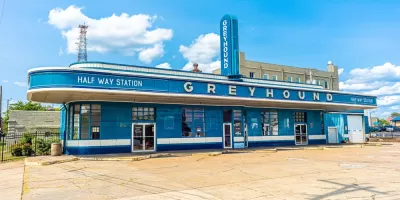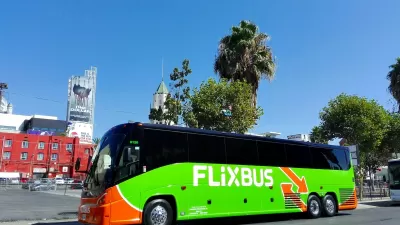The closure of many former Greyhound bus terminals is making intercity bus travel more inconvenient for the riders who depend on it.

Intercity bus riders are seeing a loss of dedicated bus stations and amenities. As Dan Zukowski explains in Smart Cities Dive, “After FlixMobility acquired Greyhound in October 2021, Greyhound’s former owner, FirstGroup, began selling the bus company’s real estate holdings, including its privately owned bus stations.”
Now, with many former Greyhound stations closing, bus passengers often have to wait on public sidewalks without amenities like public restrooms or air-conditioned waiting rooms. According to Joe Schwieterman, director of the Chaddick Institute for Metropolitan Development at DePaul University, “You have lots of disadvantaged populations that really suffer when indoor waiting rooms are lost, or you end up [with stops] at convenience stores and hours are limited.”
Some cities provide access to existing facilities, such as Union Station in downtown Los Angeles, but, according to an annual report on the intercity bus industry from the Chaddick Institute, “The problems this creates have yet to attract much attention from local policymakers, some of whom have done little to help travelers on intercity buses in the past.”
The report warns that the closures, along with an ongoing operator shortage, will prevent bus companies from improving services and bringing ridership back up to pre-pandemic levels. It also predicts a rise in premium services such as onboard meals and lie-flat beds to attract a wider variety of passengers.
FULL STORY: Intercity bus station closures create problems for riders

Planetizen Federal Action Tracker
A weekly monitor of how Trump’s orders and actions are impacting planners and planning in America.

San Francisco's School District Spent $105M To Build Affordable Housing for Teachers — And That's Just the Beginning
SFUSD joins a growing list of school districts using their land holdings to address housing affordability challenges faced by their own employees.

The Tiny, Adorable $7,000 Car Turning Japan Onto EVs
The single seat Mibot charges from a regular plug as quickly as an iPad, and is about half the price of an average EV.

Seattle's Plan for Adopting Driverless Cars
Equity, safety, accessibility and affordability are front of mind as the city prepares for robotaxis and other autonomous vehicles.

As Trump Phases Out FEMA, Is It Time to Flee the Floodplains?
With less federal funding available for disaster relief efforts, the need to relocate at-risk communities is more urgent than ever.

With Protected Lanes, 460% More People Commute by Bike
For those needing more ammo, more data proving what we already knew is here.
Urban Design for Planners 1: Software Tools
This six-course series explores essential urban design concepts using open source software and equips planners with the tools they need to participate fully in the urban design process.
Planning for Universal Design
Learn the tools for implementing Universal Design in planning regulations.
Smith Gee Studio
City of Charlotte
City of Camden Redevelopment Agency
City of Astoria
Transportation Research & Education Center (TREC) at Portland State University
US High Speed Rail Association
City of Camden Redevelopment Agency
Municipality of Princeton (NJ)





























